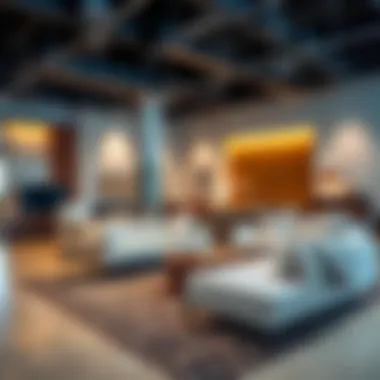Exploring Dubai's Furniture Industry: Key Players and Trends


Intro
Dubai's furniture scene is more than just a marketplace; it is a tapestry woven with rich cultural heritage and modern innovation. The city's unique blend of traditions influences everything from design aesthetics to consumer preferences. For investors, real estate developers, and buyers, understanding this dynamic landscape becomes essential for making informed decisions in an ever-evolving market.
As the city burgeons into a global hub for commerce and tourism, the furniture industry serves as a vivid reflection of those transformations. With key companies at the forefront, the industry invites exploration into market trends and sways of consumer behavior. From high-end artisanal pieces that tell a story to sleek, minimalist designs catering to modern tastes, Dubai's furniture offerings are as diverse as its populace. Whether you are a seasoned stakeholder or a first-time home buyer looking to adorn your space, grasping the nuances of this market can aid in navigating the complexities ahead.
In this comprehensive guide, we will delve deeper into the property market’s insights, the essential steps to consider when buying or selling, and the pivotal companies driving this industry forward.
Overview of the Furniture Industry in Dubai
The furniture industry in Dubai acts not just as a business sector, but as a reflection of the city’s rapid growth and cultural diversity. This metropolis has emerged as a central hub in the Middle East, where innovative design and luxury converge. Understanding the landscape of furniture in Dubai is crucial for anyone looking to invest or participate in this market, as it showcases the blend of modernity and tradition.
Market Evolution and Trends
Over the past few decades, Dubai's furniture industry has undergone significant transformations. Initially dominated by traditional Arabic designs, the market has expanded to include a variety of styles that cater to the international populace residing in the city. From sleek Scandinavian aesthetics to vibrant and eclectic Mediterranean influences, the evolution reflects the multicultural character of Dubai.
Major trends have emerged, driven by factors such as urbanization and the changing lifestyles of residents. Currently, there is a strong inclination towards sustainable materials and practices. Buyers are becoming more conscious of environmental impacts, thus prompting many companies to rethink their approaches. Moreover, the rise of online shopping has altered consumer behaviors, making digital accessibility a vital aspect for furniture retailers.
An interesting point to note is the significance of major real estate projects, such as Dubai Marina and the Palm Jumeirah, which have further increased demand for unique and high-end furniture pieces. as such developments attract affluent buyers and renters who seek exclusive home furnishings that reflect luxury and sophistication.
Key Drivers of Growth
Several factors are propelling the furniture industry in Dubai forward:
- Economic Stability: Dubai's robust economic environment and investor-friendly policies provide certainty for businesses. The influx of foreign investments has also stimulated growth in the real estate sector, directly influencing furniture sales.
- Cultural Acceptance: The blending of traditions encourages innovative designs. Discerning customers are eager to experiment with various styles, melding old and new.
- Luxury Demand: With a rising middle class and an ever-growing elite population, there is an insatiable demand for luxury items. High-end furniture brands tend to flourish, catering to this segment seeking exclusivity.
- Technological Advances: The adoption of advanced manufacturing techniques, like 3D printing and artificial intelligence, is streamlining production processes. Companies can now deliver customizable products faster and at lower costs.
Addressing the evolving tastes of consumers and adapting to technological advancements are pivotal for companies aiming to thrive in this competitive market.
Major Furniture Companies in Dubai
The furniture industry in Dubai is vibrant and constantly evolving, making it essential to identify the major players shaping this market. These companies play a crucial role not only in defining aesthetic trends but also in influencing purchasing behaviors of local and international consumers. As Dubai is a melting pot of cultures, the furniture offerings by its companies reflect a diverse array of styles, materials, and innovations. For investors, buyers, and professionals in interior design, understanding the landscape of major furniture companies serves several purposes:
- Market Insight: Gaining knowledge about leading suppliers helps stakeholders make informed decisions regarding product selection and investment opportunities.
- Competitive Edge: Familiarity with top brands can provide strategies to carve a niche in the competitive market.
- Consumer Preferences: Recognizing trends and preferences trends guides both retailers and manufacturers in aligning their offerings effectively.
Leaders in the Market
When it comes to the leaders within Dubai’s furniture sector, several key companies stand out due to their extensive product ranges, innovative designs, and strong brand recognition. Among them, IKEA is well-recognized globally, and its Dubai outlet attracts considerable foot traffic, catering to a wide demographic with customizable and functional designs suited for smaller spaces. Other notable names include Home Centre, which offers a mix of modern and traditional furniture, appealing to various tastes and budgets, and Pan Emirates, known for its position as a premium furniture retailer offering a luxurious shopping experience.
Emerging Players
The evolving furniture landscape in Dubai has given rise to several emerging players. Companies like The White Gallery, which focuses on high-end, bespoke pieces, and GEEPAS, supplying necessities and value-for-money options are increasingly carving out their market share. Additionally, there are startups like FurniDubai, embracing direct-to-consumer models, thus challenging the traditional retail framework. These companies bring fresh perspectives and innovation to the table, compelling established brands to adapt and respond to an audience that is increasingly demanding uniqueness and story behind the furniture they choose.
In summary, recognizing these major companies helps stakeholders in Dubai’s furniture market navigate their choices more effectively. Understanding both the leaders and the newcomers will allow for a broader appreciation of the styles and innovations that populate the market, landing a competitive advantage in this saturated environment.
Product Offerings and Innovations
The furniture industry in Dubai has evolved tremendously, and at the heart of this transformation are the product offerings and innovations that define its unique landscape. The importance of this topic cannot be overstated; understanding how companies tailor their offerings can provide critical insights for investors, buyers, agents, developers, and sellers alike.
As consumer trends shift towards personalization, the demand for tailored products rises. This creates an environment where innovation is not merely an advantage—it's essential for survival. Companies that can integrate technology and sustainability into their offerings are likely to have a competitive edge in this bustling market.
One key aspect is the blending of traditional craftsmanship with contemporary design. Many companies are finding ways to honor cultural heritage while also embracing modern aesthetics. For instance, traditional Arabic patterns and techniques are often infused into modern furniture designs. The fusion creates products that are not only functional but also deeply resonant with local culture.
Traditional vs. Contemporary Styles
The dichotomy between traditional and contemporary styles in furniture design is emblematic of Dubai’s diverse culture. Traditional styles often evoke the rich history and artistry of the region. Items such as ornate wooden tables or intricately crafted majlis seating are cherished for their cultural significance. However, with an influx of global influences, contemporary styles have gained momentum, emphasizing clean lines, minimalism, and functionality.
What’s fascinating is how some furniture brands in Dubai are adeptly merging these two styles into cohesive offerings. For example, you might find a sleek, modern chair adorned with traditional embroidery that adds a touch of authenticity without sacrificing modernity. This synthesis appeals to a wide range of customers, from expatriates seeking a sense of home to locals wanting a fresh take on heritage.
Sustainable Furniture Solutions
Sustainability has become a cornerstone of the furniture industry. Consumers today are more aware of environmental issues and often prefer brands that champion eco-friendly practices. The challenge lies in balancing design with sustainable materials without compromising quality.
Furniture companies in Dubai have begun to innovate in this space by utilizing sustainable timber, recycled materials, and non-toxic finishes. Brands are also incorporating principles of upcycling—an approach that transforms discarded materials into stylish furniture. It’s worth noting that many consumers are willing to invest more in products that reflect their values, making sustainability a lucrative market segment.
Some companies go a step further by ensuring their operations are sustainable from end to end. This includes everything from sourcing materials responsibly to ensuring their manufacturing processes reduce waste. For example, one local brand has established a take-back policy where used furniture is repurposed instead of ending up in landfills. Such initiatives not only meet consumer demand but also foster brand loyalty in an increasingly aware market.
In summary, the interplay of traditional and contemporary styles alongside a commitment to sustainability defines the furniture offerings in Dubai. Investors and buyers who recognize these trends will find themselves well-positioned to navigate this dynamic market. Understanding how product innovations resonate with customer values will undoubtedly be a guiding factor in the future success of Dubai’s furniture industry.
Cultural Influences on Furniture Design
Understanding the cultural influences on furniture design is essential for grasping how Dubai's market operates. This city, a melting pot of diverse cultures and traditions, sets the stage for a unique interplay between various design elements. Such influences don't just shape the aesthetics of furniture; they also reflect the values, lifestyles, and sensibilities of the populations that inhabit this vibrant metropolis. As investors, buyers, and sellers navigate this landscape, appreciating these cultural threads can lead to more informed decisions and enhance business strategies.
Arabic Aesthetics and Modern Interpretations
The Arabic aesthetic has deeply ingrained roots in furniture design within Dubai. Traditionally, Arabic design emphasizes intricate patterns, bold colors, and the use of rich materials. Elements like hand-carved wood, decorative metalwork, and luxurious fabrics are common. These factors collectively create an ambiance that resonates with warmth and hospitality, a hallmark of Arabic culture.
Modern interpretations have taken these traditional elements and fused them with contemporary styles. Designers are now crafting pieces that reflect minimalism while maintaining an Arabian flair. For instance, you might find a sleek, minimalist coffee table that incorporates mashrabiya—the lattice woodwork that is iconic in Arabic architecture—offering a fresh yet respectful nod to its heritage. This blend of old and new caters to a growing clientele that values sophistication paired with cultural significance.
"A piece of furniture is more than just its function; it embodies the stories and traditions of its culture."
Here are some significant features of this approach:
- Use of Natural Materials: Wood, leather, and metal remain prevalent, often sourced locally.
- Color Palette: Earthy tones mixed with vibrant splashes that mirror Dubai’s landscapes and culture.
- Cultural Symbols: The integration of motifs and symbols that communicate deeper connections to heritage.


Globalization and Its Impact
With the ever-increasing globalization, the furniture industry in Dubai reflects influences that transcend its local borders. This is particularly noticeable in how businesses now cater to expatriates and tourists who bring with them a medley of tastes and preferences. As a result, the solutions offered by companies range widely—ranging from European chic to Asian minimalism, appealing to a cadre of discerning clientele.
Moreover, global designs often find their place alongside local craftsmanship, creating dynamic products that can resonate across diverse markets. Here are some impacts of globalization on furniture design in Dubai:
- Diverse Inspirations: Designers are able to draw upon a wider range of styles, often mixing elements from different traditions.
- Innovation in Materials and Techniques: Exposure to international practices leads to the adoption of advanced manufacturing technologies and materials.
- Increased Competition: Local companies must adapt by innovating or risk losing ground to international brands entering the market.
In summary, the cultural influences on furniture design in Dubai blend traditional Arabic aesthetics with modern interpretations. They are also shaped significantly by globalization. As the market continues to evolve, these elements drive creativity and foster competition, presenting unique opportunities for stakeholders involved in this intricate industry.
Consumer Preferences in Dubai's Furniture Market
Understanding consumer preferences in Dubai's furniture market is essential for anyone looking to navigate this dynamic landscape. The tastes and priorities of buyers significantly influence product offerings and design choices within the industry. In this vibrant metropolis, consumers are not just seeking functional pieces; they are also on the lookout for items that align with their lifestyle, cultural influences, and emerging interior design trends. Exploring these preferences reveals insights that can guide investors, buyers, and sellers in a profitable direction.
Target Demographics
Dubai is a melting pot of cultures, and its furniture market caters to a diverse demographic. Here, you'll find wealthy expatriates, local Emiratis, and a growing number of young professionals. Each group has its unique set of preferences. For instance, expatriates often lean towards contemporary styles that harmonize with global trends, while local Emirati families may favor luxurious, traditional designs that respect their heritage. The housing arrangements also play a critical role: lavish villas may require opulent furniture choices, whereas affordable apartments often lead to more minimalistic tastes.
- Wealthy Residents: Typically prefer bespoke pieces that reflect status and often go for brands like Eureka, which provide high-end options.
- Middle-income Professionals: Generally opt for functional and stylish yet affordable furniture from stores such as IKEA or Home Centre.
- Emirati Culture: Traditional furniture styles, often characterized by intricate craftsmanship and rich textiles, capture the preferences of local families.
Drawing these demographics into focus is critical for those engaged in the furniture sector. By understanding their preferences, businesses can tailor their marketing and product strategies effectively.
Interior Design Trends
Current interior design trends in Dubai showcase a blend of aesthetics from around the world, incorporating cultural motifs with modern sensibilities. Notably, the fusion of Arabic aesthetics with contemporary flair is paving the way for unique furniture designs that resonate with the local populace.
- Emphasis on Sustainability: An increasing number of consumers are considering environmentally friendly options. Brands that utilize eco-friendly materials and sustainable practices are quickly gaining favour among conscious buyers.
- Minimalism and Functionality: Unlike the opulent designs that once dominated, many now favour a minimalist aesthetic that combines sleek lines and multipurpose functionality, especially in smaller living spaces.
- Biophilic Design: Integrating natural elements into furniture and décor is another trend gaining traction, with many consumers looking to create serene and organic living environments.
"The furniture choices reflect more than mere aesthetics; they represent a lifestyle, a connection to the culture, and a statement of identity for residents in Dubai."
Embracing these trends is vital for any company aiming to stay relevant in such a rapidly evolving market. Staying attuned to the pulse of consumer preferences not only enriches business strategies but also enhances the overall shopping experience for consumers.
Challenges Facing Furniture Companies
Navigating the intricate landscape of the furniture industry in Dubai poses numerous challenges for businesses striving for success. The dynamic nature of this marketplace, while brimming with opportunities, is not without its complications. Understanding the hurdles that furniture companies face can shed light on strategies necessary for thriving in this competitive environment. This section will illuminate key obstacles, such as supply chain issues and the pressures of competition and market saturation. Both elements play a crucial role in shaping the decisions that companies must make to ensure sustainability and development.
Supply Chain Issues
Supply chain issues stand as a significant hurdle for furniture companies in Dubai. These problems often arise from various factors, including global logistics disruptions and the dependence on imported materials. With an increasing demand for quality products, delays in sourcing raw materials can substantially impact production timelines.
For instance, companies that rely heavily on imports from countries like China or Italy may experience lead time fluctuations due to geopolitical factors, regulatory changes, or unforeseen natural disasters. Furthermore, local suppliers may not always meet the standard required for high-end furniture, thus forcing companies to look further afield, which complicates logistics even more.
"The success of any furniture company is intimately tied to its supply chain efficiency. Any hiccup can send ripples across production and ultimately affect customer satisfaction."
In light of this, many firms are exploring alternative strategies to mitigate these risks. Companies are increasingly embracing transparency within their supply chains, utilizing technology to track materials' journey. Diversifying supplier bases becomes a paramount consideration. By having multiple sources for needed materials, businesses can better insulate themselves from potential shortages. Moreover, investing in local craftsmanship can reduce reliance on imports entirely, contributing to sustainability while addressing delays.
Competition and Market Saturation
In a city as glamorous as Dubai, the furniture market is teeming with both established industry giants and innovative newcomers. This competitive landscape can lead to market saturation, making differentiation vital for survival. Companies faced with similar product offerings and target demographics must continually innovate to capture customer attention.
Distinctive branding becomes a significant factor of competition. Companies need to showcase their unique selling propositions effectively, whether through high-quality craftsmanship, innovative designs, or eco-conscious practices. It’s not just about competing on price, as many consumers are willing to pay a premium for sustainability or ethical sourcing of materials.
The digital era has transformed competition in the furniture industry, too. E-commerce platforms allow consumers to browse extensive collections from the comfort of their homes, increasing the competition for foot traffic in showrooms. This has resulted in a trend toward enhancing the online shopping experience. Companies are investing in immersive technologies, making product selection more engaging and aligned with contemporary consumer habits.
To navigate this crowded field, the ability to adapt marketing strategies remains pivotal. Engaging with consumers through social media or other platforms can foster brand loyalty and keep a company top-of-mind. Additionally, customer feedback can provide invaluable insight into market sentiments, enabling businesses to pivot and innovate as needed.
In summary, while the challenges facing furniture companies in Dubai may seem daunting, they also provide fertile ground for strategic thinking. By addressing supply chain difficulties and navigating the competitive landscape wisely, businesses can carve out a stable presence in this vibrant market.
Designing for the Future
Designing for the future is not merely a trendy phrase; it is a crucial consideration for decision-makers and stakeholders in Dubai's furniture industry. This focus on future-oriented design is fundamentally about adapting to imminent challenges and opportunities shaped by technology, sustainability, and consumer expectations. In a city characterized by relentless innovation, the furniture landscape must evolve to maintain relevance and meet the preferences of an increasingly sophisticated market.
Incorporating elements of foresight in design ensures that furniture remains not only functional but also anticipatory of future trends and technologies. For instance, smart furniture, equipped with connectivity features, is gaining traction. Products that integrate seamlessly with smart home technology can enhance user experience, offering convenience that today's consumers crave. By prioritizing technological advancements, furniture companies can position themselves as front-runners in a competitive market.
Technological Innovations in Furniture
Technological innovations in furniture design often center on functionality and user interaction. Take, for instance, advancements such as 3D printing, which allows manufacturers to create bespoke pieces tailored to individual specifications. This method reduces material waste and enables rapid prototyping, streamlining the production process while catering to unique customer preferences.
Moreover, augmented reality (AR) has made significant inroads in furniture retail, enabling customers to visualize furniture in their own homes before making a purchase. When shoppers can see how a specific piece fits into their personal space, the likelihood of satisfaction and return on investment increases.
Key innovations to consider include:
- Smart furniture integrating IoT for enhanced living environments.
- Customizable designs, allowing consumers to choose configurations and materials.
- Sustainable manufacturing processes leveraging technology to minimize eco-footprint.
Incorporating these trends can elevate a brand's reputation, attracting a clientele that values modern solutions.
Adapting to Changing Consumer Needs
As the taste of consumers shifts, furniture design must mold itself to these changing needs. Dubai's market is diverse; a blend of expatriates and locals drives various consumer preferences. Understanding these demographics—ranging from young professionals to affluent families—is essential. Companies should conduct thorough market research, facilitating adaptability and responsiveness in design.
An important consideration is the shift towards sustainability. As awareness around environmental issues grows, more consumers are looking to purchase eco-friendly products. Furniture made from recycled materials or designed for longevity is becoming increasingly appealing. Businesses that prioritize sustainability not only appeal to this conscientious market but also contribute to the broader goal of ecological responsibility.
Additionally, remote work has transformed how consumers perceive their spaces. Home offices have become a necessity, prompting companies to design versatile furniture that accommodates both work and leisure seamlessly. Adapting offerings to provide multifunctional solutions can foster greater customer satisfaction and brand loyalty.
"To stay afloat in today’s furniture market, adaptation is as vital as creation. Brands must constantly reevaluate their designs and approaches to keep pace with evolving demands."


Evaluating Quality and Craftsmanship
Evaluating quality and craftsmanship is pivotal in Dubai's furniture industry. In a market where luxury and aesthetics converge, the standards of production directly impact consumer trust and brand reputation. Buyers not only seek stylish and innovative pieces but also the assurance that these items will withstand the test of time. Understanding the nuances of quality can streamline purchasing decisions for investors, buyers, and industry stakeholders alike.
Material Selection
The selection of materials plays a crucial role in determining the durability and appeal of furniture. In Dubai, where environmental conditions can be challenging, thoughtful material choices enhance longevity and performance. Whether it's the selection of hardwoods like oak or walnut, known for their resilience, or the use of engineered wood that offers innovative benefits, each choice must align with design intent and functionality.
- Natural Materials: Solid woods are favored for high-end pieces not only for their strength but also for their unique grain patterns. They tell a story, adding character to furniture.
- Sustainable Options: As environmental consciousness grows, many companies explore bamboo and reclaimed wood. These materials not only provide aesthetic charm but also minimal ecological impact.
- Upholstery and Finishes: Fabrics and finishes merit careful evaluation. Leather, for instance, provides luxury but requires maintenance. Meanwhile, synthetic fabrics offer durability and ease of care for high-traffic areas.
In Dubai, consumers are becoming more discerning. They often inquire about the source of materials and manufacturing methods. This knowledge facilitates informed choices, aligning personal values with purchasing decisions.
Manufacturing Standards
Manufacturing standards serve as the backbone of quality assurance in furniture production. In Dubai's competitive landscape, companies that adhere to strict quality guidelines distinguish themselves in the market. This includes not only complying with local regulations but also aligning with international best practices.
- Quality Control Processes: Establishing robust inspection protocols is essential. Many companies employ rigorous testing phases, from design mock-ups to finished pieces, ensuring they meet predefined standards.
- Certifications: Look for furniture with certifications such as ISO, which indicates a commitment to quality management systems. This assurance can significantly influence a buyer's confidence as they consider high-budget investments.
- Workmanship Insights: The skill level of craftsmen shapes the overall quality. Artisans trained in traditional techniques often produce unique pieces that can't be replicated by machines. In Dubai, where heritage meets modernity, understanding this blend is essential for descerning buyers.
"A truly exceptional piece of furniture is not just about its outward beauty; it lies in the heart of its creation and the hands that shape it."
As stakeholders evaluate quality and craftsmanship, consideration of these elements aids in discerning the best offerings from the bustling furniture scene in Dubai. Understanding the intricacies involved in material selection and manufacturing standards can lead to more satisfying purchases that reflect both individual taste and practical needs.
Logistics of Furniture Delivery in Dubai
Effective logistics management is a backbone of the furniture industry in Dubai. Given the city's rapid growth and ever-changing skyline, the logistics of furniture delivery not only impact customer satisfaction but also influence the overall success of businesses within the sector.
When navigating the complex terrain of deliveries, companies must consider several factors like timely transportation, storage solutions, and compliance with local regulations. With the diverse demographics in Dubai – including expats, tourists, and local residents – understanding various needs is paramount. A streamlined logistics process ensures that furniture reaches end consumers swiftly and safely, reinforcing a company’s reputation.
In a bustling marketplace like Dubai, where consumers are often in a hurry, ensuring a fast delivery time can set a brand apart from its competitors. Companies that master logistics can capitalize on customer preferences for immediate gratification while increasing their own operational efficiency.
Distribution Channels
Distribution channels in Dubai's furniture sector are as varied as the styles of furniture itself. The interplay of traditional and modern distribution methods offers something for everyone. Some companies opt for direct sales through their showrooms, while many others embrace a multi-channel approach that includes third-party retailers, online platforms, and local dealerships.
Considerations for effective distribution include:
- Location of Warehouses: Proximity to both the consumer base and suppliers can reduce transit times and costs.
- Partnerships with Freight Carriers: Engaging with reliable logistics providers can optimize delivery routes and schedules.
- Transport Modes: Utilizing trucks, boats, or even drones ensures flexibility and adaptability in meeting delivery demands.
Companies like IKEA, known for its accessibility, often choose urban warehouses that allow for rapid distribution. In contrast, smaller companies might need to rely on partnerships with local transport services to deliver their products efficiently.
E-commerce and Online Retail
The surge in e-commerce has dramatically reshaped the furniture delivery landscape in Dubai. With consumers increasingly turning to online shopping, companies have adapted by investing in robust online platforms that enhance customer experience. The convenience of browsing and purchasing from home has become a staple for many, creating an overwhelmingly digital-first market.
To remain competitive in the e-commerce space, brands must focus on:
- User Experience: Websites should be intuitive, showcasing products with high-quality images and detailed descriptions.
- Efficient Checkout Processes: Facilitating a smooth transaction can significantly reduce cart abandonment rates.
- Responsive Customer Support: Availability of live chat or prompt email responses can enhance consumer trust and satisfaction.
Moreover, companies are increasingly using augmented reality technology to allow customers to visualize furniture in their own spaces before making a purchase. This not only improves sales but also decreases return rates, a key consideration for online retailers.
Ultimately, investing in a sound logistics strategy that integrates e-commerce will empower companies to tackle the unique challenges of the furniture market in Dubai while catering to a demanding customer base.
Sustainability Initiatives in the Furniture Sector
Sustainability is no longer just a buzzword; it has become a crucial part of how businesses operate, especially in the furniture sector. In a rapidly evolving world, where climate change and environmental concerns are front and center, companies in Dubai increasingly recognize the significance of sustainable practices. This proactive approach yields not only ecological benefits but also economic advantages by meeting consumer demands and enhancing brand reputation.
Recycling and Upcycling Practices
The concept of recycling has taken root deeply within the furniture industry. Many companies are embracing the idea of reusing materials that would otherwise end up in landfills. For instance, IKEA has implemented a program aiming to become a circular business by 2030, which includes reclaiming old furniture for recycling. By turning waste into resources, these companies can offer new products made from old materials, thus lowering the demand for virgin resources.
Upcycling is another innovative practice that has caught on. It leverages creativity, transforming the old into something functional and aesthetically pleasing. Businesses like Tashkeel in Dubai exemplify this with their handcrafted furniture using recycled materials. They not only create unique pieces but also tell a compelling story about the origins of the materials. The allure of such customized fine furniture can attract a conscious consumer base, inclined to support businesses that contribute positively to the environment.
"Adopting recycling and upcycling practices in furniture design is not just a way to improve sustainability, but an opportunity to demonstrate artistry and innovation."
Benefits of Recycling and Upcycling Practices
- Reduced Waste: Eases the burden on waste management systems and reduces landfill usage.
- Conservation of Resources: Limits the need for raw materials, making the manufacturing process more sustainable.
- Economic Growth: Fosters local artisans and encourages entrepreneurial ventures within the community.
Eco-friendly Materials and Processes
In search of sustainability, the choice of materials is paramount. Many furniture companies in Dubai are shifting towards eco-friendly materials like bamboo, reclaimed wood, and even recycled metals. Bamboo, in particular, is celebrated for its rapid growth, making it a renewable resource that can be harvested sustainably. This material not only looks good but is also incredibly durable and versatile—a win-win!
Moreover, companies are exploring sustainable manufacturing processes to minimize environmental footprints. The use of non-toxic finishes and glues, for instance, reduces the harm that volatile organic compounds (VOCs) can have on indoor air quality. Firms like The Nook highlight eco-conscious living through their commitment to sustainable fabric choices and waste reduction in production.
Key Considerations in Using Eco-friendly Materials
- Certifications and Standards: Look for labels like FSC (Forest Stewardship Council) to assure responsible sourcing.
- Life Cycle Assessment: Evaluate the environmental impact of materials from sourcing through disposal.
- Consumer Demand: As awareness for sustainability rises, the shift to eco-materials can cater to conscientious buyers seeking ethical options.
Consumer Rights and Responsibilities
Understanding consumer rights and responsibilities plays a crucial role in the furniture market in Dubai. As buyers, individuals must grasp not just their purchasing power but also their entitlements and duties in the marketplace. The furniture industry, known for its mix of luxury and accessibility, invites a variety of consumer engagements, thus bringing these rights and responsibilities to the forefront.
When investing in furniture, consumers are assured protection under the law, which covers aspects such as quality, durability, and safety of the products. This means that if a buyer spends hard-earned money on a couch or dining set, they can expect the item to function correctly without defects. But it isn't just about what the seller can deliver; it's equally about how the consumer interacts with these regulations, exercising their rights responsibly.


Understanding Warranty Terms
Warranties are a pivotal component of the purchasing process in the furniture sector. They serve as a safeguard for the consumer, providing a promise that the product meets certain standards for a specified period. In Dubai, understanding the fine print of warranty terms can save consumers both time and money.
A warranty can vary significantly from one company to another. Some may offer a lifetime warranty, while others may limit their coverage to just a year. It’s essential for buyers to do their homework:
- Duration of the Warranty: How long does the warranty last?
- Coverage Details: What exactly is covered? Material defects, poor craftsmanship?
- Claim Process: What steps must a consumer follow to claim warranty?
- Exclusions: Be aware of what isn’t covered, this might include damages due to misuse or wear and tear.
When you understand these terms, you're better equipped to make informed decisions. For instance, if a premium sofa comes with a ten-year warranty while a budget version has only a year, it may indicate differences in expected durability. As always, reading the fine print could shine a light on your choices, helping to avoid unpleasant surprises down the line.
Returns and Exchanges Policies
No one likes the frustration of buying an item that just doesn’t fit or isn’t quite right for their space. Returns and exchanges policies therefore become significant factors that influence a consumer's shopping experience. In Dubai's bustling furniture market, where showrooms often differ in their approaches, understanding these policies is vital for a smooth transaction.
Typically, furniture companies in Dubai may have varying return and exchange times, ranging from a few days to weeks. Here are a few things every consumer should inquire about before making a purchase:
- Time Frame for Returns: How long does the consumer have to decide?
- Condition of Items: Must items be returned in their original packaging? Are there any exceptions?
- Refund Method: Will refunds be issued in cash or store credits?
- Exchanging Items: What is the process if a consumer wishes to exchange a piece for a different size or style?
Understanding the penalties and limitations of returns can save a lot of grief. Always inquire upfront to prevent headaches later.
Being informed about these policies means consumers can shop with confidence, knowing they have options should something go amiss. In a rapidly-growing market like Dubai's, where styles and preferences can shift with the wind, having these safety nets in place assures buyers of their choices.
The Role of Technology in Furniture Shopping
In today’s fast-paced world, technology has woven itself into the very fabric of our daily lives, shaping not just how we communicate and consume media but also how we shop for furniture. In the heart of Dubai's burgeoning furniture market, innovation stands tall, altering the way consumers interact with products. Integrating advanced technology into the shopping experience, companies are stepping up their game to meet the high expectations of buyers. The role of technology in furniture shopping, therefore, is essential not only for enhancing customer satisfaction but also for driving growth in a competitive landscape.
Virtual Reality and Augmented Reality Applications
Virtual and augmented reality technologies have revolutionized the furniture shopping experience. Picture this: you’re sitting in your living room, smartphone in hand, and with a simple app, you can view how a new sofa would fit within your space. Companies like IKEA have rolled out AR applications that allow consumers to visualize furniture pieces in their own homes, thereby bridging the gap between contemplation and acquisition.
The benefits of this growing trend are multifaceted:
- Enhanced Visualization: Customers can envision furniture within their own spaces, turning abstract options into tangible choices.
- Reduction in Returns: By facilitating better decision-making upfront, VR and AR significantly cut down on return rates, which can otherwise be a financial burden for businesses.
- Interactive Engagement: These applications create a play-like environment that captures consumer interest, making shopping not just a task, but an enjoyable experience.
"With technology, the art of visualization transforms shopping from a chore into an interactive journey."
Online Customization Options
Online customization has emerged as another pivotal aspect of the furniture shopping experience. Companies are embracing the shift towards more personalized services, allowing consumers to tailor products to align with their distinct tastes and requirements. From the selection of materials to adjusting dimensions, buyers can design furniture that speaks to their personal style.
This approach offers various advantages:
- Personal Touch: Customization fosters a feeling of ownership and individuality, resulting in products that resonate more strongly with buyers.
- Increased Satisfaction: When people build their furniture rather than simply buy it, they often report higher satisfaction levels. This emotional engagement leads to stronger brand loyalty.
- Unique Offerings: For companies, the ability to provide tailored options sets them apart in a saturated market, drawing in consumers seeking something special.
Many brands have adopted user-friendly interfaces on their websites to streamline this customization process. Whether it's using a sliding scale to adjust size or choosing a fabric from a virtual catalogue, these features enhance usability while fulfilling diverse consumer needs.
In summary, the trajectory of technology in furniture shopping is one toward innovation and personalization. As Dubai continues to solidify its position as a global business hub, companies that keep pace with these trends stand to reap significant rewards.
Showroom Experiences: Crafting Customer Engagement
The dynamic nature of Dubai's furniture market has made showroom experiences a pivotal component in crafting meaningful customer engagement. In a city where luxury meets modernity, a well-designed showroom is not just a space to display products; it serves as a portal that invites customers into a world of potential. By blending aesthetics with interactivity, showrooms can significantly influence consumer decisions, ultimately steering them towards making a purchase.
In this context, it's imperative for companies to consider several key elements when curating their showroom environment:
- Visual Appeal: A showroom must captivate the customer’s eye from the moment they step inside. Color schemes, layout, and lighting all work together to create an inviting atmosphere. A thoughtfully arranged space, where furniture pieces are strategically placed to highlight versatility and functionality, makes a lasting impression.
- Product Accessibility: Customers appreciate being able to explore and touch the products. An effective showroom presents items at varying heights and configurations, ensuring potential buyers can interact with them comfortably. This tangible experience can transform a mere browse into an emotional connection to the product.
- Customer Journey: Understanding the customer journey is crucial. A well-laid-out showroom guides visitors through a seamless flow—transitioning from one setup to another, allowing them to envision how the pieces might fit into their lives.
- Feedback Mechanism: Incorporating a simple way to gather customer feedback is also essential. This could be a digital touchpoint or physical suggestion box. Such feedback can reveal vital insights about consumer preferences and areas for improvement.
"The showroom is more than a display; it’s a stage where customers envision their future spaces."
In-store Design Consultations
An integral part of the showroom experience in Dubai is the offering of in-store design consultations. These consultations provide a level of personalization that many buyers crave. Customers often walk into a showroom without a clear idea of what they need, overwhelmed by choices. Here, trained consultants come into play.
- Personalized Advice: Consultants take the time to understand individual tastes and requirements. This bespoke service isn’t just about selling furniture—the aim is to solve problems and enhance living spaces. They can provide recommendations based on style, space utility, and even local trends, tailoring their advice to fit the customer's unique vision.
- Visualization Tools: Many showrooms are incorporating technology to aid in consultations. Tools that allow customers to visualize how furniture will look in their own homes can make a significant difference. This could involve augmented reality applications, showcasing potential layouts without any physical commitment.
Immersive Displays and Interaction
The rise of immersive displays and interaction within showrooms signifies a trend towards deeper engagement. Traditional displays are giving way to innovative layouts that stimulate the senses.
- Interactive Stations: Showrooms are incorporating interactive stations where customers can engage with products through touch-screens or demos. This not only provides valuable information but also turns the shopping experience into a fun activity.
- Real-life Simulations: Creating realistic living scenarios within the showroom can provide customers with inspiration. Room setups that imitate various home styles showcase how the furniture fits into different environments—be it minimalist, bohemian, or modern luxury.
- Event Hosting: Conducting workshops or lifestyle events can elevate the customer experience. These gatherings allow people to explore design ideas and build a community around the brand, anchoring it firmly in their minds.
For investors and stakeholders, understanding these showroom experiences is not merely beneficial; it’s essential. They represent a strategic investment in customer relationships that leads to loyalty and repeat business in a highly competitive market. As Dubai continues to grow as a hub for diverse cultural influences, these experiential elements will be a reflection of evolving consumer expectations and values.
Future Outlook for Furniture Companies in Dubai
The future of furniture companies in Dubai is a topic of increasing importance as stakeholders from various sectors, including investors, agents, and consumers, begin to gauge the vitality of this space. With Dubai evolving as a key trade and design hub in the Middle East, understanding the future outlook can provide essential insights for navigating potential opportunities and challenges. For those looking to engage in this dynamic market, it's crucial to focus on emerging market trends, consumer behaviors, and innovative strategies that could sculpt the landscape of furniture business in the coming years.
Predicted Market Trends
As we look ahead, several key trends are predicted to make substantial impacts on the furniture market in Dubai:
- Sustainable Practices: There is a growing awareness of sustainability among consumers globally, and Dubai is no different. Companies are focusing on eco-friendly designs that incorporate renewable materials.
- Smart Furniture: The integration of technology into furniture is gaining traction. From charging stations embedded in desks to smart furniture that adapts to user preferences, innovation will drive new sales.
- Customization and Personalization: Consumers are moving away from traditional, mass-produced furniture. Instead, they seek pieces that reflect their personal taste, leading to a rise in bespoke offerings from local manufacturers.
- Omni-channel Shopping Experiences: With the rise of e-commerce, many furniture companies are enhancing their online presence while maintaining robust showrooms. Offering seamless shopping experiences that integrate online and offline channels will be crucial.
- Cultural Sensitivity in Design: As Dubai remains a melting pot of cultures, designs that reflect local aesthetics while also incorporating modern trends are likely to resonate well with a diverse clientele.
"In today's fast-paced world, being ahead of trends can set a company apart in a crowded marketplace."
Strategies for Sustained Growth
Navigating the future demands not just an understanding of trends but effective strategies to ensure sustained growth. Furniture companies in Dubai might consider the following approaches:
- Investing in Technology: Embracing new technologies for production and logistics can lead to enhanced efficiency and lower costs. Technologies like AI can assist in better inventory management and customer service.
- Strong Online Presence: Developing a strong online brand presence is vital. This could involve creating engaging content on platforms like Instagram and design forums or utilizing targeted ads on e-commerce websites to reach specific demographics.
- Collaborations and Partnerships: Forming strategic alliances with designers, architects, or even artists can foster unique offerings that differentiate a brand from competitors. Such collaborations can also open doors to new markets.
- Focus on Customer Experience: This includes improving customer service, creating engaging showroom experiences, and offering extended warranties or return policies. A satisfied customer is often a repeat customer.
- Adapting to Market Needs: Companies that remain adaptable and responsive to the evolving market can capitalize on new opportunities—be it design trends or economic shifts. This agility will determine long-term viability in a rapidly changing landscape.
As Dubai's furniture sector stands on the brink of transformation, the companies that ready themselves with informed predictions and strategic planning will likely thrive. Understanding these emerging aspects is crucial not only for industry insiders but also for anyone looking to invest in or engage with this dynamic market.











